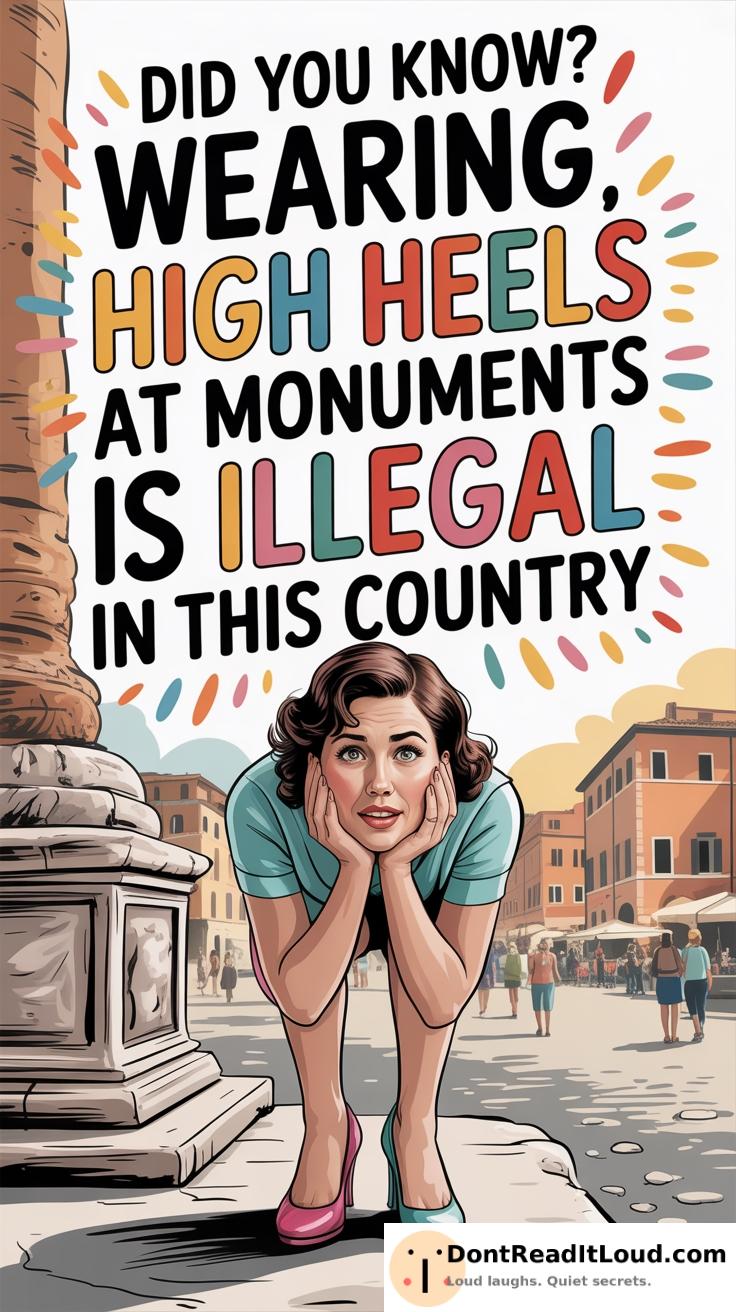
Did you know that in Greece, wearing high heels at historical monuments is illegal? This rule was introduced in the early 2000s to prevent damage to ancient sites, especially to delicate materials like marble. The law highlights Greece’s commitment to protecting its cultural heritage and encourages everyone to help preserve these historic places. If you’re interested in how other countries approach conservation, there are plenty of fascinating examples to explore.
The Origin of This Law

The law banning high heels at certain monuments began in Greece, designed to protect ancient sites from harm. This rule was introduced as Greece worked to safeguard its valuable heritage. The regulation emerged in the early 2000s, when increased tourism threatened the stability of historic landmarks.
Greece boasts some of the world’s most important archaeological treasures, such as the Acropolis and other ancient ruins. High heels can focus pressure on the ground, risking damage to marble and stone. To address this, the Greek Ministry of Culture and Tourism enacted the ban as part of wider preservation efforts.
The Acropolis in Athens is a prime example of why the rule is necessary. As millions walk its marble pathways, sharp heels can speed up erosion and wear. By enforcing this law, Greece helps protect the site’s integrity for the future.
Banning high heels at monuments is a sensible step in Greece’s ongoing conservation mission, highlighting the nation’s dedication to its historic sites.
Why This Law Exists

The law prohibiting high heels at monuments in certain countries exists for practical, cultural, and preservation reasons.
Practically, high heels can damage historic sites. High heels have narrow tips that focus pressure on the ground, causing wear on ancient floors and structures. This is a major concern for monuments built from softer materials like marble or sandstone, which can chip or crack under concentrated force. Banning high heels helps protect and extend the life of these invaluable sites.
Culturally, monuments are often viewed as sacred places that reflect national pride and history. Maintaining their condition shows respect for the past and preserves a sense of identity. The ban on high heels is a simple but important step in safeguarding these landmarks for future generations.
Politically, such laws demonstrate a dedication to heritage preservation, which can foster national pride and support tourism. Well-maintained monuments attract more visitors and enhance a country’s reputation as a guardian of cultural treasures.
This law also signals a clear priority for cultural heritage, resonating with both locals and tourists.
How This Law Reflects it’s Culture?

The law banning high heels at monuments in Greece highlights the nation’s deep respect for its historical sites and dedication to preserving cultural heritage. In Greece, these monuments are regarded not just as tourist destinations, but as vital symbols of national identity and history. This law shows the importance placed on protecting ancient structures from even minor harm.
Countries with long histories, like Greece, often take great pride in maintaining their historical landmarks. These sites serve as direct links to the past, representing the achievements and stories of previous generations. By enforcing this rule, Greece demonstrates its commitment to keeping these sites safe for future visitors.
The law also reflects a shared cultural value of caring for public heritage. In Greece, people widely accept that preserving these monuments is a communal duty. This belief is taught in schools and reinforced in everyday life, making respect for historical sites part of the national character.
On a practical level, the law addresses the risk that high heels pose to fragile ancient surfaces. By restricting their use, Greece seeks to prevent unnecessary damage and prolong the life of these precious sites.
Ultimately, the rule against high heels at Greek monuments is more than a regulation; it expresses the country’s reverence for history and its collective responsibility to honor and protect the past.
What Happens If You Break This Law?

In some countries, specific laws or regulations ban wearing high heels at certain monuments or historical sites. This helps protect delicate flooring and ancient structures from damage.
If someone breaks this rule, the consequences can vary depending on the country and site.
- Fines: The most common consequence is a fine, which can range from a small amount to a significant penalty, depending on the site’s rules.
- Legal Consequences: Offenders may be removed from the premises and possibly banned from returning. In serious cases involving significant damage, further legal action or criminal charges could follow.
- Public Reaction: In places where historical preservation is highly valued, breaking this law may result in public criticism, negative media attention, or backlash on social media, especially for public figures.
- Education and Awareness: Sometimes, violators receive educational materials explaining why these rules exist, encouraging respect and care for cultural sites in the future.
Could Other Countries Learn from This Law?

In Greece, the law prohibiting the wearing of high heels at certain ancient monuments is rooted in the desire to preserve these historical sites from damage. High heels can cause significant wear and tear on the fragile structures, leading to deterioration over time. This law reflects a proactive approach to cultural preservation, balancing public access with conservation efforts.
When comparing this approach to how other countries handle similar situations, several points emerge:
- Italy: Italy, home to numerous ancient sites, has implemented various conservation laws, including restrictions on eating near monuments and fines for vandalism. However, specific bans on footwear like high heels aren’t common. Instead, Italy focuses on broader conservation measures such as limiting the number of visitors or closing certain areas to the public when necessary.
- Egypt: In Egypt, the preservation of monuments such as the pyramids involves strict regulations concerning tourist interactions. While there are guidelines on climbing and touching certain structures, there’s less emphasis on footwear restrictions. However, the broader approach includes significant fines for damaging artifacts or sites.
- Cambodia: At Angkor Wat, Cambodia emphasizes the preservation of its ancient temples through guidelines that focus on respectful behavior, including dress codes for modesty. The focus here is on cultural respect rather than specific footwear restrictions, although visitors are encouraged to wear appropriate shoes for the terrain.
- United States: In the U.S., national parks and monuments have rules aimed at preservation, such as designated paths and areas to prevent erosion and damage. Footwear restrictions aren’t typically part of the regulations, but visitors are often advised on suitable footwear for safety and comfort.
Can other countries learn from Greece’s specific law on high heels? The answer is yes and no:
- Yes, they can learn: Greece’s law exemplifies a specific, targeted measure to address a particular risk to ancient structures. Other countries with similar fragile sites could consider implementing specialized restrictions based on the unique vulnerabilities of their monuments. This could help in crafting more nuanced preservation strategies.
- Too unique to replicate: The law is tailored to Greece’s specific context, where high heels pose a direct threat to the integrity of ancient marble and similar materials. In countries where the threats to monuments differ, such as environmental factors or mass tourism, this approach may be less applicable. Instead, countries may need to devise tailored strategies that address their unique conservation challenges.
Ultimately, Greece’s law highlights the importance of adapting preservation strategies to fit the specific needs of cultural heritage sites. While the high heels ban may not be directly applicable everywhere, the principle of targeted, context-specific conservation measures is a valuable lesson for global heritage management.
Conclusion: What Makes this Law So Unique
The law banning high heels at monuments in certain countries stands out for its cultural significance and specificity. By targeting a particular visitor behavior, it highlights the dedication to preserving historic sites.
This regulation reflects a strong commitment to protecting national heritage and preventing damage from footwear that could harm ancient structures. It also reveals a deep respect for history and the desire to maintain these landmarks for future generations.
Other nations might benefit from adopting similarly precise rules to safeguard their own cultural sites. Focusing on site preservation helps ensure that these places remain valuable for both education and tourism.
This law illustrates the need to balance public access with the responsibility of protecting irreplaceable monuments. It encourages creative approaches to heritage conservation while respecting contemporary habits.



